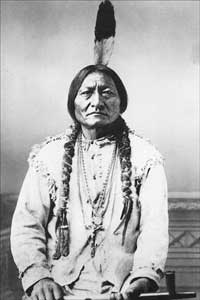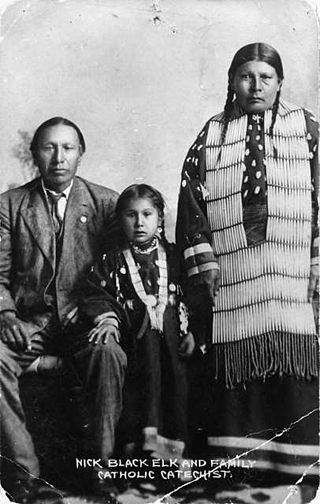Related Research Articles

The Lakota are a Native American people. Also known as the Teton Sioux, they are one of the three prominent subcultures of the Sioux people, with the Eastern Dakota (Santee) and Western Dakota (Wičhíyena). Their current lands are in North and South Dakota. They speak Lakȟótiyapi—the Lakota language, the westernmost of three closely related languages that belong to the Siouan language family.

Box Butte County is a county in the U.S. state of Nebraska. As of the 2020 United States Census, the population was 10,842. Its county seat is Alliance. The county was formed in 1886; it took its name from a large box-shaped butte north of Alliance.

Banner County is a county in the western part of the U.S. state of Nebraska in the Great Plains region of the United States. As of the 2020 United States Census, its population was 674. Its county seat is the unincorporated community of Harrisburg; there are no incorporated municipalities within the county.

Cheyenne County is a county located in the northwest corner of the U.S. state of Kansas. Its county seat and most populous city is St. Francis. As of the 2020 census, the county population was 2,616. The county was named after the Cheyenne tribe.

Heȟáka Sápa, commonly known as Black Elk, was a wičháša wakȟáŋ and heyoka of the Oglala Lakota people. He was a second cousin of the war leader Crazy Horse and fought with him in the Battle of Little Bighorn. He survived the Wounded Knee Massacre in 1890. He toured and performed in Europe as part of Buffalo Bill's Wild West.

John Milton Chivington was a Methodist pastor and Mason who served as a colonel in the United States Volunteers during the New Mexico Campaign of the American Civil War. He led a rear action against a Confederate supply train in the Battle of Glorieta Pass, and was then appointed a colonel of cavalry during the Colorado War.

The Sioux Wars were a series of conflicts between the United States and various subgroups of the Sioux people which occurred in the later half of the 19th century. The earliest conflict came in 1854 when a fight broke out at Fort Laramie in Wyoming, when Sioux warriors killed 31 American soldiers in the Grattan Massacre, and the final came in 1890 during the Ghost Dance War.
The Battle of Warbonnet Creek was a skirmish characterized by a duel between "Buffalo Bill" Cody and a young Cheyenne warrior named Heova'ehe or Yellow Hair. The engagement is often referred to as the First Scalp for Custer. It occurred July 17, 1876, in Sioux County in northwestern Nebraska.

The Colorado War was an Indian War fought in 1864 and 1865 between the Southern Cheyenne, Arapaho, and allied Brulé and Oglala Sioux peoples versus the U.S. Army, Colorado militia, and white settlers in Colorado Territory and adjacent regions. The Kiowa and the Comanche played a minor role in actions that occurred in the southern part of the Territory along the Arkansas River. The Cheyenne, Arapaho, and Sioux played the major role in actions that occurred north of the Arkansas River and along the South Platte River, the Great Platte River Road, and the eastern portion of the Overland Trail. The United States government and Colorado Territory authorities participated through the 1st Colorado Cavalry Regiment, often called the Colorado volunteers. The war was centered on the Colorado Eastern Plains, extending eastward into Kansas and Nebraska.

Lindy is an unincorporated community and census-designated place located on the Santee Sioux Reservation in Knox County, in the northeastern part of the state of Nebraska in the Midwestern United States. As of the 2010 census it had a population of 13.
The Church of Immaculate Conception is a Roman Catholic parish church under the authority of the Roman Catholic Archdiocese of New York, located in Amenia, Dutchess County, New York. It was established as a parish in 1866.

St. Henry's Catholic Church is a historic Catholic parish in the rural community of Harriettsville in the southeastern part of the U.S. state of Ohio. Established for German settlers in the 1860s, it worships in a landmark church building constructed in the 1890s. As the only stone building in the area and the work of a prominent architect, it has been named a historic site.

Immaculate Conception Catholic Church is a historic Catholic parish at Fulda in rural Noble County, Ohio, United States. Established in the 1840s among a group of German immigrants, it worships in a landmark building that dominates the surrounding community. The building has been named a historic site.

The Church of the Immaculate Conception is a historic Roman Catholic church building in the unincorporated community of St. Anna, Minnesota, United States. It is part of the Roman Catholic Diocese of Saint Cloud. The church was constructed in 1902 in a rural community settled by Polish immigrants. It was listed on the National Register of Historic Places in 1982 for its state-level significance in the themes of architecture, exploration/settlement, and religion. It was nominated for reflecting the settlement of rural Stearns County by Catholic immigrant groups clustered in small, ethnic hamlets dominated by a central church.

Saint Leonard Catholic Church is a Roman Catholic church in the city of Madison, in the state of Nebraska in the Midwestern United States. Built in 1913, it has been described as "an outstanding example of the Romanesque Revival style of architecture."

Yocemento is an unincorporated community in Big Creek Township, Ellis County, Kansas, United States. The settlement lies across the banks of Big Creek against the base of bluffs capped by massive limestone blocks, in which lies the 20th-century origin of the community.
This timeline of South Dakota is a list of events in the history of South Dakota by year.

Porcupine was a Cheyenne chief and medicine man. He is best known for bringing the Ghost Dance religion to the Cheyenne. Raised with the Sioux of a Cheyenne mother, he married a Cheyenne himself and became a warrior in the Cheyenne Dog Soldiers.

Rome was a short-lived postbellum frontier settlement in Big Creek Township, Ellis County, Kansas, United States. It is notable for its association with the early plains career of its co-founder, William Frederick "Buffalo Bill" Cody. Rome was the first town established within the future Ellis County, followed very shortly by rival Hays City.
References
- ↑ U.S. Geological Survey Geographic Names Information System: Montrose, Nebraska
- 1 2 3 4 5 6 7 8 9 Louis Berger Group (August 2005). Nebraska Historic Buildings Survey Sioux County (PDF). Nebraska State Historical Society. Archived from the original on November 16, 2006. Retrieved June 26, 2017.
{{cite book}}: CS1 maint: unfit URL (link) - ↑ Fitzpatrick, Lillian L. (1960). Nebraska Place-Names. University of Nebraska Press. p. 137. ISBN 0-8032-5060-6. A 1925 edition is available for download at University of Nebraska—Lincoln Digital Commons.
- ↑ "Sioux County". Jim Forte Postal History. Retrieved August 23, 2014.
42°55′21″N103°43′44″W / 42.92250°N 103.72889°W
